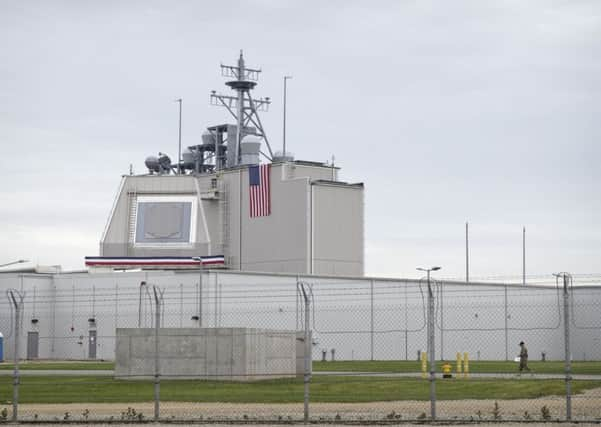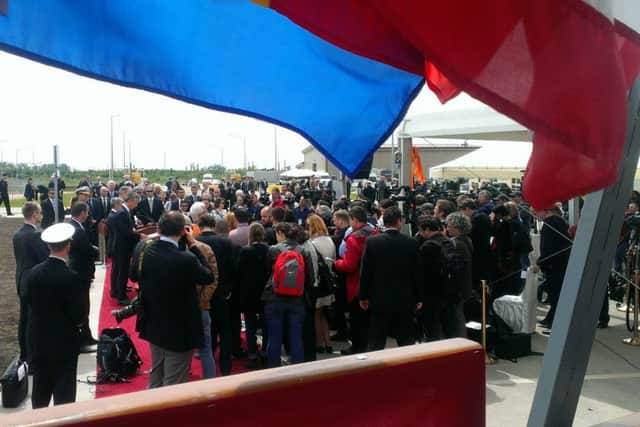Reagan's '˜star wars' dream comes to fruition in Eastern Europe


A new missile defence system opened in a military base called Devesulu, in a southern Romanian plane.
The system is the partial fruition of Ronald Reagan’s much talked about, and sometimes mocked, ‘star wars’ scheme to shoot approaching ballistic missiles out of space.
Advertisement
Hide AdAdvertisement
Hide AdThe former president of the United States unveiled the idea when he launched the so-called Strategic Defense Initiative (SDI) in 1983 to protect America from attack. Back then it seemed an almost fanciful proposal.


Over the decades, technology improved and the plans evolved, later becoming the Ballistic Missile Defense Organisation (BMDO).
The $800 million (£550m) Nato facility in Romania is a move towards the achievement of that vision, and complements a radar facility in Turkey and four sophisticated naval destroyers, based in a Spanish port, that can sail around the European continent and so maximise the range of Nato’s protection.
The launch at Devesulu on Thursday was followed on Friday by a ceremony at the Polish village of Redzikowo, near the Baltic Sea, where Polish and US officials broke ground at a further missile defence site in that is set to go online in 2018.
Advertisement
Hide AdAdvertisement
Hide AdAll four branches of the missile defence programme – Turkey, Romania, Poland and the ships – are under the control of a command centre in Ramstein, Germany.


They form part of the so-called European Phased Adaptive Approach, which is gradually but continually improving Nato’s missile defences.
Russia is furious at the new facilities. President Vladimir Putin described the programme on Friday as a threat to global security and warned that Moscow will take measures to maintain a parity in security.
The News Letter was at the Romanian opening on Thursday, where Nato officials were at pains to insist that the new site development is aimed at protecting against growing short and medium term missile threats from the Middle East.
Advertisement
Hide AdAdvertisement
Hide AdIt is not, they say, capable of providing protection from Russia’s intercontinental missiles, or even orientated towards that country.
The system is geared towards tackling dangers posed by countries such as Iran, which has been testing ballistic missiles, despite the nuclear deal with the West.
Devesulu can track such missiles, and intercept them within minutes, and so it forms an important piece of the European defence jigsaw.
While the Americans are emphasising that the new missile facility is not aimed in any way at Russia, guarding Europe against Russian aggression is nonetheless one of Nato’s key overall roles at present.
Advertisement
Hide AdAdvertisement
Hide AdRelations between Moscow and the alliance have been poor since the conflict in Ukraine, in which Russia annexed Crimea two years ago and gave backing to pro-Moscow rebels in the east of Ukraine.
While Nato has deployed naval vessels to the Black Sea and sent troops to eastern Europe in a bid to reassure countries in the region, it is still keen to ensure that the facilities in Romania and Poland will not raise tensions with Russia.
It points out that the go-ahead for Devesulu was given in 2010, well before the tensions erupted over Ukraine.
The project has been controversial with Russia, but is a cornerstone of Nato’s efforts to improve its defences.
Advertisement
Hide AdAdvertisement
Hide AdThe unveiling ceremony was attended by Nato, Romanian and US officials, including Nato’s secretary general, Jens Stoltenberg, and America’s deputy secretary of defence, Robert Work.
Douglas Lute, the US permanent representative to Nato, told this newspaper that activation of Devesulu had improved European security.
ANALYSIS:
Northern Ireland often seems safe and far removed from global missile threats, and in a sense it is so, given that the Province is geographically on the fringe of Europe.
NI is towards the bottom of the target list of any likely enemy of the continent. But London is very much in the firing line.
Advertisement
Hide AdAdvertisement
Hide AdAny attack on the UK’s capital city would have disastrous consequences for the entirety of the United Kingdom.
Devesulu forms part of the protection of such European capitals from the terrifying prospect of incoming Ballistic missiles.
Nato has been central to Britain’s defences since we joined the organisation as a founding member in 1949. Only foolish politicians, such as the Labour Party of the 1980s and Jeremy Corbyn throughout his career, have advocated UK withdrawal from Nato.
It might feel sensible for the government of a small country such as the Republic of Ireland to declare itself neutral and to stay outside of Nato, but it would be a notable waving of the white flag by the UK if it was to quit the group that has helped maintain peace in Europe since shortly after the Second World War.
Advertisement
Hide AdAdvertisement
Hide AdThe perceived threat for most of that time came from the Soviet Union, and the tense nuclear weapon stand-off. Now that threat is greatly reduced, but Moscow’s activities in Ukraine shows that friendship with the West is a long way off.
I asked Nato diplomats at Devesulu why, in light of recent Russian aggression, they felt the need to be so apologetic about the new missile systems. They said that they were responding to wild Russian claims about Nato intentions.
Most expert defence commentators, however, believe that the new facilities could indeed tackle Russian medium range threats but accept that that capacity genuinely was not the primary motive and say that Americans are trying to avoid triggering a fresh nuclear tit-for-tat.
The threat from the Middle East is the main focus for Devesulu.
However, the rise of Isis and different forms of terrorism illustrates that Devesulu and the other new missile defences will only be able to tackle one aspect of that rising threat.